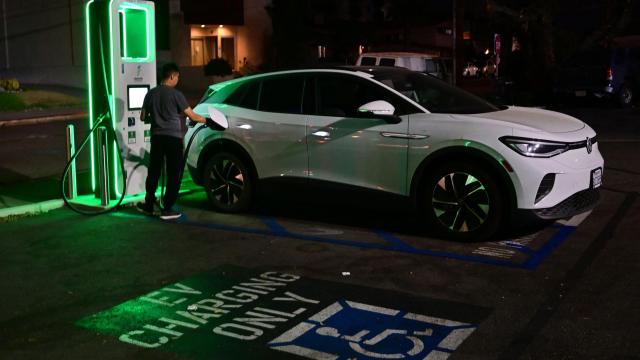Transitioning to electric vehicles is going to take some getting used to, and the biggest pain point is charging. It’s also an EV’s not-so-secret weak spot, but it’s not just the long charge time and frustrations over actually finding a charger. A new story from Heatmap details just how many ways chargers have been blocked, hacked or knocked offline by ill-wishers.
The problem, Heatmap points out, is obvious: EV chargers are not overseen by a human being. They can exist in deserted parking lots, the roofs of parking garages or behind businesses where both charger and EV owner are more vulnerable to misuse and abuse:
During daylight hours, this setup means customers can charge while visiting stores at the mall or having a meal, but at night, these parking lots are deserted. A charging station does not need a human attendant, so the late-night EV traveller may find themselves alone. A midnight thief, meanwhile, might find the station unguarded. Last summer, Vice reports, bandits stole cords from chargers in Reno, Nevada, while cars were in the middle of charging. One happened at a hotel, another at a mall. In Los Angeles, a station saw all its wires cut on Earth Day last year.
Copper thieves, just like those who are stealing a rash of catalytic converters from gas and hybrid cars, have a clear economic motivation. But EVs are also vulnerable to attackers motivated by politics or spite. Tesla owners have used the car’s “Sentry Mode,” which records what the vehicle cameras are seeing, to catch a variety of vandals targeting the cars, some of whom seem driven by dislike of EVs or of Tesla and outspoken CEO Elon Musk. When a Florida couple saw their charging cable destroyed while their Chevy Bolt was plugged in at home — requiring them to buy a $US450 replacement — they thought someone was trying to “send them a message.”
So far, vandalism incidents have been relatively rare. A spokesperson for Electrify America, for example, told me they account for less than 1 per cent of the company’s charger repairs, and that it installed extra lighting and cameras in places with recurring issues. But that’s not the only concern. Charging stations are also linked to the internet in order to process payments and monitor their status, and anything that’s connected is inherently hackable. This January, someone had a laugh remotely hijacking the screens that control Electrify America chargers.
From thieves stealing copper to pranksters cutting wires or vandals shoving meat into chargers (as happened in Germany), to hacking for financial gain, to jerks who just park their ICE vehicles in front of chargers; the potential for hi jinx with barely any oversight seems limitless. A few security cameras aren’t going to detour the most determined thieves and chaos-makers.
It’s not just the actual act of charging either; paying at a charger leaves EV owners to financial attacks. We even saw chargers in Russia go down after the country’s invasion of Ukraine last year when their Ukrainian manufacturer used backdoor access to shut them down.
The problem of local and lack of oversight at chargers has been obvious for a while at least to women auto buyers. Women are much more likely to transition back to gasoline cars after buying an EV than men. The prospect of sitting motionless and alone in a dark parking lot for a half hour at a time likely doesn’t inspire American women go (or stay) green.
Read more at Heatmap for what can (and will) happen to EV chargers as we head towards an increasingly electric future.
